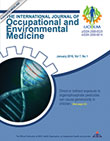فهرست مطالب

International Journal of Occupational and Environmental Medicine
Volume:7 Issue: 1, Jan 2016
- تاریخ انتشار: 1395/02/18
- تعداد عناوین: 8
-
-
Pages 1-14BackgroundMental health issues in the workplace are a growing concern among organizations and policymakers, but it remains unclear what interventions are effective in preventing mental health problems and their associated organizational consequences. This synthesis reports on workplace mental health interventions that impact absenteeism, productivity and financial outcomes.ObjectiveTo determine the level of evidence supporting mental health interventions as valuable to work outcomes.MethodsDatabases were searched for systematic reviews between 2000 and 2012: Medline, EMBASE, the Cochrane Database of Systematic Reviews, DARE, CINAHL, PsycINFO and TRIP. Grey literature searches included health-evidence.ca, Rehab, National Rehabilitation Information Center (NARIC), and Institute for Work and Health. The assessment of articles for inclusion criteria and methodological quality was conducted independently by two or more researchers, with differences resolved through consensus.ResultsThe search resulted in 3363 titles, of which 3248 were excluded following title/abstract review, with 115 articles retrieved for full-text review. 14 articles finally met the inclusion criteria and are summarized in this synthesis.ConclusionThere is moderate evidence for the effectiveness of workplace mental health interventions on improved workplace outcomes. Certain types of programs, such as those incorporating both mental and physical health interventions, multicomponent mental health and/or psychosocial interventions, and exposure in vivo containing interventions for particular anxiety disorders had a greater level of research evidence to support their effectiveness.Keywords: Mental health, Workplace, Outcome assessment (Health care), Health care costs, Efficiency, Presenteeism, Absenteeism, Review [Publication type], Social support, Anxiety disorders, Risk factors
-
Pages 15-21BackgroundNoise-induced hearing loss (NIHL) is a common, irreversible occupational disease. Statins have recently been proposed to prevent NIHL.ObjectiveTo assess the effect of atorvastatin for the prevention of NIHL in rats.MethodsIn this experimental study, forty 23-month-old Wistar male rats were divided into 5 groups of 8 animals. 3 groups of rats received atorvastatin at doses of 5, 25, and 50 mg/kg daily for 14 days. The 4th group of rats received normal saline; another group was the control group. After 2 weeks of treatment, the rats were exposed to broad-band noise (12520 000 Hz) at 110 dB-SPL intensity for 2 hours. Response amplitude of all ears at 5 frequencies was assessed by distortion product otoacoustic emissions (DP-OAE) at baseline, 2 hours, and 2 weeks after the exposure.ResultsResponse amplitude was significantly decreased at all frequencies immediately after exposure to noise in all studied groups. The amplitude increased after 72 hours to a level higher than temporary threshold shift (TTS); this change was only significant in the group received 5 mg/kg atorvastatin.ConclusionLow dose atorvastatin (5 mg/kg) used before exposure to noise can probably prevent NIHL in rats. This effect was not observed with higher doses of the drug.Keywords: Hearing loss, noise-induced, Otoacoustic emissions, spontaneous, Atorvastatin, Antioxidants, Occupational diseases
-
Pages 22-32BackgroundNon-communicable diseases (NCDs) and psychological hazards are increasingly observed in industries, necessitating the need to strengthen industrial health systems to control the same. District level data on level of functioning of industrial health systems and services with special focus on systems available for mental health care is lacking in India. This information is vital to plan need-based interventions for system strengthening.ObjectiveTo assess the status of functioning of industrial health systems and services in Kolar district, India, with special focus on systems and services available for mental health care.MethodsThis cross-sectional study was undertaken between October and December 2014 on a stratified random sample of 69 industries located in Kolar, which were stratified proportionately by their hazardous nature. Interview and observation checklist were used to assess and classify functioning of industrial health systems and services including those available for mental health care.ResultsOccupational safety and health (OSH) policy was present in 56% and health insurance in 39% of the 69 industries assessed. Pre-placement and periodical medical examination were conducted in 23% of industries. Health systems and services in hazardous industries were functioning at less than 50% level of functioning. Health systems and services for mental health care were non-existent.ConclusionThere is a need in Kolar district, India, to integrate the mental health components within existing industrial health systems, as per policy directives to implement setting based approaches in mental health programs.Keywords: Health systems, Mental health services, Occupational health, Delivery of health care, Industry, Mental health, Risk, Mental disorders, Insurance, health, India
-
Pages 26-27
-
Pages 33-41BackgroundProfessional burnout is defined as a state of depletion and loss of motivation accompanied by different mental and physical symptoms.ObjectiveTo assess personal losses suffered by correctional officers due to burnout.MethodsThis cross-sectional study conducted between June and December 2012 included 201 correctional officers in two Bulgarian prisons. The mean age of the whole group was 41.2 (SD 8.0) years. The respondents was mostly male (56.7%), married (72.6%), had a secondary educational level (61.7%), and 76.1% of them had been in current prison work over 5 years.ResultsThe demographic characteristics had no influence on the occurrence of burnout but there was a correlation between level of burnout and the number of sick-leaves, the need for medical help, and the expenses spent on medications. Officers affected by burnout took more sick-leaves and this affected adversely their remuneration as they lost 3.1% of their annual wages. Their expenses spent on user fees for medical services were 3 times higher. Their monthly expenses spent on medications were 3.14 times higher than those of people without the burnout syndrome.ConclusionThe high level of burnout has a negative personal economic effect on the prison employees.Keywords: Burnout, professional, Police, Prisons, Health care economics, organizations, Bulgaria
-
Pages 42-51BackgroundAgriculture is an important sector for the Malaysian economy. The use of pesticides in agriculture is crucial due to its function in keeping the crops from harmful insects. Children living near agricultural fields are at risk of pesticide poisoning.ObjectiveTo evaluate the genotoxic risk among children who exposed to pesticides and measure DNA damage due to pesticides exposure.MethodsIn a cross-sectional study 180 Orang Asli Mah Meri children aged between 7 and 12 years were studied. They were all living in an agricultural island in Kuala Langat, Selangor, Malaysia. The data for this study were collected via modified validated questionnaire and food frequency questionnaire, which consisted of 131 food items. 6 urinary organophosphate metabolites were used as biomarkers for pesticides exposure. For genotoxic risk or genetic damage assessment, the level of DNA damage from exfoliated buccal mucosa cells was measured using the comet assay electrophoresis method.ResultsOut of 180 respondents, 84 (46.7%) showed positive traces of organophosphate metabolites in their urine. Children with detectable urinary pesticide had a longer tail length (median 43.5; IQR 30.9 to 68.1 μm) than those with undetectable urinary pesticides (median 24.7; IQR 9.5 to 48.1 μm). There was a significant association between the extent of DNA damage and the children's age, length of residence in the area, pesticides detection, and frequency of apple consumption.ConclusionThe organophosphate genotoxicity among children is associated with the amount of exposure (detectability of urinary pesticide) and length of residence in (exposure) the study area.Keywords: Organophosphates, Pesticides, Organophosphate poisoning, Mutagenicity tests, Comet assay, Child, Malaysia


